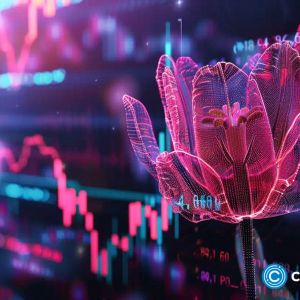Summary Trading volumes for spot bitcoin ETFs have been the talk of the industry. ETF market makers are selling to new investors and need to create new shares to cover the short positions. For investors who define liquidity as the ability to enter and exit a position with minimal market impact, I would think metrics such as premium/discount to NAV would be far more relevant than average daily volume. By David Mann, Head of ETF Product & Capital Markets, Franklin Templeton The Fund has filed a registration statement (including a prospectus) with the Securities and Exchange Commission ("SEC") for the offering to which this communication relates. Before you invest, you should read the prospectus in that registration statement and other documents the Fund has filed with the SEC, when available, for more complete information about the Fund and this offering. You may obtain these documents for free by visiting EDGAR on the SEC website at SEC.gov or by visiting franklintempleton.com. The 2024 exchange-traded funds (ETFs) "story of the year" has been the meteoric adoption rate of the nine spot bitcoin ETFs that launched on January 11, 2024. Through the end of February, combined net inflows for these ETFs reached US$16 billion, with a notional trading volume of US$45 billion. 1 Given that all these funds hold the same thing (bitcoins), with many issuers waiving fees to zero and tracking similar benchmarks, investors have turned to measuring stats associated with "liquidity" as a way to differentiate. Not surprisingly, many of the misconceptions for measuring ETF liquidity that I've discussed previously have resurfaced. I am going to discuss those here, while also acknowledging some bitcoin-specific wrinkles. Lastly, I checked in with my son on the best way to make the spot bitcoin ETF liquidity story relatable for all readers. Per his instructions, I'll use the Detroit Lions' chances of winning the 2025 Super Bowl as the perfect analogy. My very first blog post back in 2016 discussed the misconceptions of using average trading volume as an accurate gauge of an ETF's liquidity. Before discussing trading volume, I want to clear a few other ETF metrics off the spot bitcoin ETF comparison board: Bid/Ask Spread: Per each ETF's website, most of these new ETFs trade at a penny spread, meaning that the difference between the bid and the ask price of a spot bitcoin ETF share is just one cent. AUM : I would also remove assets under management ((AUM)) from the ETF liquidity conversation - AUM is an important consideration relating to percent of ownership limits, not the ability to buy and sell bitcoins or the cost associated with doing so. That leaves volume . Average daily volume simply shows how much other people have traded in the past. Importantly, it does not provide any information on what price investors paid for their ETF shares, especially in relation to the fund's net asset value (NAV). I also think volume is particularly misleading for these bitcoin ETFs given the unique nature of having a few new funds each holding a brand-new underlying asset, all launching on the same day. Typically, for a new fund, every dollar traded on exchange should lead to a dollar of primary market activity. I have discussed these ratios in the past since, typically for new funds, there aren't existing shareholders who would sell shares to new investors. Instead, ETF market makers are selling to new investors and need to create new shares to cover those short positions. For investors who define liquidity as the ability to enter and exit a position with minimal market impact, I would think metrics such as premium/discount to NAV would be far more relevant than average daily volume. That's especially true when comparing multiple ETFs that own the same underlying asset. The ratio of exchange volume to primary market activity for these nine funds is almost three-to-one. I can speculate as to the reasons. I think given the volatile nature of bitcoin, there's been a fair amount of day trading, with investors buying and selling frequently but ending with no long position. I also think there are professional firms that are buying/selling all these funds simultaneously whenever there are any premium/discount differences. Consider this ETF arbitrage on steroids. And if that is, in fact, happening, why should an ETF get extra credit for receiving elevated volume due to increased premiums/discounts? Back to premiums/discounts. For a true apples-to-apples comparison, I looked at the six ETFs that use the CME CF Bitcoin Reference Rate - New York variant, as different benchmarks could result in misleading data. The three largest of those ETFs (each with over $1.5 billion of AUM) have traded on average $280 million a day. The three smallest of those ETFs have collectively averaged $10 million of trading volume per day. The weighted premium/discount to NAV for those three largest funds is 16 basis points. For the bottom three (which includes EZBC , Franklin's spot bitcoin ETF), that weighted average is seven basis points. 2 By that metric, I would argue that the lower volume spot bitcoin funds have been more liquid in terms of an investor's ability to trade in-line with the underlying price of bitcoin. My son was right in his NFL analogy to reinforce this point. On a quick side note, I received some unnecessarily harsh feedback from my readers for 1) being a Detroit Lions fan and 2) picking them to win the Super Bowl this year. Anyway, the day after the Super Bowl, my son was curious about the likelihood the Lions could win the Super Bowl in 2025. I showed him a grid that lists the odds for each team across six different sports books. For the Lions, the odds ranged from 12-to-1 (wager $1 to win $12) to 13.5-1 (wager $1 to win $13.50), depending on the sports book. His next comment was rightfully, "Oh, so we should go to the sports book that pays 13.5-1." While clearly there are no guaranteed payouts in investing (if only!), he did not ask me which sports book took the most bets, nor did he ask which sports book had the most action on the Detroit Lions. His focus was on what impacted his investment in Detroit's winning the Super Bowl. I'd argue that for ETFs, metrics such as premium/discount to NAV are more relevant to liquidity than trading volume and AUM. I can only hope to see such enlightenment in the spot ETF bitcoin world. What Are The Risks? All investments involve risks, including possible loss of principal. The value of investments can go down as well as up, and investors may not get back the full amount invested. Generally, those offering potential for higher returns are accompanied by a higher degree of risk. Stock prices fluctuate, sometimes rapidly and dramatically, due to factors affecting individual companies, particular industries or sectors, or general market conditions. For actively managed ETFs, there is no guarantee that the manager's investment decisions will produce the desired results. ETFs trade like stocks, fluctuate in market value and may trade above or below the ETF's net asset value. Brokerage commissions and ETF expenses will reduce returns. ETF shares may be bought or sold throughout the day at their market price on the exchange on which they are listed. However, there can be no guarantee that an active trading market for ETF shares will be developed or maintained or that their listing will continue or remain unchanged. While the shares of ETFs are tradable on secondary markets, they may not readily trade in all market conditions and may trade at significant discounts in periods of market stress. 1. Source: Bloomberg. As of March 1, 2024. 2. Source: Ibid. Original Post Editor's Note: The summary bullets for this article were chosen by Seeking Alpha editors.












